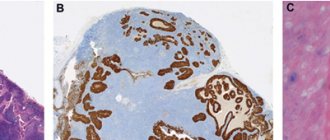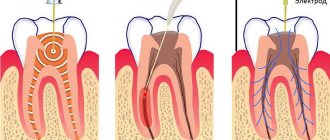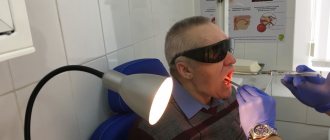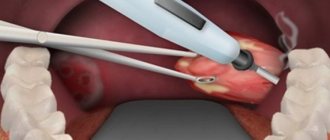Enlarged tonsils in a child are not a disease, but a symptom that signals pathological changes occurring in the young body. As practice shows, parents go to the doctor only if the baby’s body temperature increases, since it is believed that temperature is the only significant signal indicating that the child is sick. And this is a big mistake. The condition when one tonsil is larger than the other, or both are enlarged at once, can occur without fever or sore throat. And it also requires increased attention from parents.
Why do tonsils get enlarged? Tonsils are special organs of the immune system in the human nasopharynx. They consist of lymphoid tissue, protect the body from pathogens and prevent their further spread. The leading role in the body belongs to the palatine tonsils, or tonsils. The tonsils are located on the sides of the pharynx and meet infection that has entered through inhaled air or food. As soon as viruses and bacteria come into contact with the surface of the tonsils, the child's tonsils enlarge. At this time, there is an increased production of leukocytes - cells that attack and destroy the infection. When an enemy is defeated, the tonsils return to their original size. In other words, the large size of the palatine tonsils indicates that they are fighting pathogenic microflora.
But even when the tonsils are in a healthy state, it is important not to lose vigilance: normally, every person has bacteria on their mucous membranes that do not manifest themselves in any way, but under the influence of favorable conditions, they begin to multiply, provoking hypertrophy of the tonsils. These reasons for enlarged tonsils in children include:
- hypothermia;
- allergic reactions;
- deviated nasal septum;
- chronic diseases of the ENT organs;
- too dry air;
- living in a place with an unfavorable environment.
The degree of enlargement of the tonsils.
There are four stages of enlargement of the tonsils. At the first stage, the tonsils occupy a third of the space between the pharynx and the palate. In this case they are said to be slightly enlarged. Symptoms of the disease do not manifest themselves in any way.
At the second stage, the tonsils already occupy half of the free space. There is discomfort when swallowing liquids, food and breathing. Tissue hypertrophy is average.
In the third stage, swallowing becomes very difficult as the lymphoid tissue increases to an impressive size.
The fourth stage is characterized by severe hypertrophy, when the tonsils completely block the pharynx. This condition interferes with proper breathing and nutrition.
If inflammation of the tonsils begins, without timely treatment, the stages quickly replace each other.
1.General information
Hypertrophy means an abnormal or pathological increase in the size of an organ, structure, or tissue. This concept should be clearly distinguished from terms (and the phenomena they denote) such as hyperplasia, tumor or edema.
Hyperplasia, for example, is the rapid growth of tissue due to a hormone-mediated increase in the number of healthy cells typical of a given tissue; the tumor process is characterized by a local increase in the number of cells with certain abnormalities and, finally, edema is an excessive accumulation of fluid in the cells or intercellular space.
In contrast to the above, hypertrophy is an increase not in the number of cells, but in their size - with a relatively normal quantity for a given organ - and is considered as a response to certain factors, conditions, influences.
Further, the tonsils (medical lat. “tonsilla”, incorrectly “tonsils”) are a group of glandular formations from lymphoid tissue, collectively making up the so-called. lymphadenoid pharyngeal ring and perform mainly the role of an immune barrier at the entrance to the respiratory and digestive tracts, in close proximity to the brain and sensory organs - in an area where many blood vessels, nerve tracts, lymph nodes and ducts are concentrated. In other words, the presence of the pharyngeal ring here as an outpost of the immune system is completely understandable; however, the tonsils also perform other functions that have not yet been studied enough or are completely unknown.
The most significant is a pair of relatively large palatine tonsils located on either side of the entrance to the laryngopharynx.
Tonsil hypertrophy is common in the general population with an estimated incidence of 5-10 to 40 percent. The vast majority of primary patients with this diagnosis are children and, less often, adolescents. Hypertrophic enlargement of the tonsils, which develops in adulthood, is sporadically rare.
A must read! Help with treatment and hospitalization!
When should you see a doctor?
If parents notice that their child’s tonsils have become enlarged, this is a good reason to take the child to an ENT doctor. The sooner the problem is identified and the throat is treated, the more favorable the prognosis will be.
And of course, there is no need to postpone a visit to the otolaryngologist if, in addition to the hypertrophied tonsil, the following signs are noticeable:
- constant sore throat;
- large lymph nodes, which also hurt a lot;
- red throat;
- white palate;
- plaque on the surface of the tonsils;
- dryness and sore throat;
- difficulty swallowing.
All these symptoms may not be accompanied by an increase in temperature, but regardless of this, they require examination by an ENT doctor.
If a child has an enlarged tonsil on one side, this is an alarming sign. In addition to classic inflammation, this condition may indicate the formation of a peritonsillar abscess or phlegmon. These are purulent inflammations of the pharynx. Both conditions require surgical treatment. Otherwise, pus may enter the body and lead to sepsis.
3. Symptoms and diagnosis
It should be especially emphasized that hypertrophy itself is not an inflammatory process and should not be perceived as equivalent to tonsillitis (acute or chronic inflammation of the tonsils). Until the tonsils reach a certain size, a person may not experience any discomfort at all.
However, over time, the anomaly begins to affect itself and takes on an increasingly distinct pathological character, simultaneously causing a cascade of progressive disorders and changes in the ENT organs.
Diction is impaired, speech becomes nasal, nasal breathing becomes difficult, which may become impossible in the future. As a result, the patient is forced to constantly breathe through his mouth, which in a few years, and even faster during periods of rapid growth, can significantly change the maxillofacial proportions (“adenoid face”). With further growth of the tonsils, the pharyngeal outlet of the auditory tube is blocked and hearing loss gradually increases, swallowing becomes difficult, bad breath appears, and the patient loses body weight.
Inadequate breathing leads to chronic hypoxia; the result is fatigue, emotional instability, and decreased intellectual and mental productivity. Sleep becomes disturbed, restless and often interrupted, a tendency to snore appears and intensifies, episodes of night cough and apnea (complete cessation of breathing, sometimes for tens of seconds) may occur. The patient does not get enough sleep, and the above disorders progress in a vicious circle.
As can be seen from the above, hypertrophy of the tonsils is by no means an asymptomatic and harmless process; on the contrary, it creates combined and quite serious threats to health, and not only in the otorhinolaryngological field.
Diagnosing this situation is quite simple: a history and complaints are collected, a standard examination of the ENT organs is carried out using spatulas, dilators and mirrors. A clinical blood test is prescribed, which in this case has its own correlates of hypertrophy, in contrast to the biochemical picture of other diseases. X-ray or tomographic imaging is used as needed.
A differential diagnosis must be carried out between “pure” hypertrophy and the hypertrophic variant of chronic tonsillitis, tumor processes, etc.
About our clinic Chistye Prudy metro station Medintercom page!
Treatment.
An effective treatment tactic will be chosen by an ENT doctor only after the cause of tonsil hypertrophy has been established.
Depending on the cause of inflammation, the patient is prescribed:
- antibacterial drugs if the causative agent of the disease is bacteria. Moreover, the medicine must be taken “from start to finish” - a strictly defined number of days, even if the child feels better. Continuous treatment is the key to a quick recovery without complications;
- antiviral drugs, if the causative agent of the disease is a viral infection;
- antifungal agents, if the cause of inflammation is fungi;
- gargling and irrigating the throat with antiseptics - constantly gargling is necessary to wash away pathogenic flora from the mucous membranes;
- antihistamines to relieve tissue swelling, and if the cause of throat discomfort is an allergic reaction;
- washing the lacunae of the palatine tonsils from pathogenic flora (it is optimal to start washing from 6-7 years of age);
- physiotherapeutic procedures (laser, ultrasound, photodynamic therapy, ultraviolet exposure, etc.)
Some parents believe that it is easier to remove the tonsils and get rid of the problems associated with them. But this is not a solution! Removal requires strict indications: more than four sore throats during the year, bad rheumatic tests, peritonsillar abscess and complications in the heart, kidneys and joints. If there are no indications, you need to be observed by an ENT doctor and, if necessary, carry out timely treatment.
GBOU "NIKIO im. L.I. Sverzhevsky" of the Moscow Department of Health
Hypertrophy of the lingual tonsil
The lymphadenoid tissue of the root of the tongue is presented in the form of two clusters of large follicles located in rows or in random groups. These clusters are separated by a central groove extending from the middle of the lingual epiglottis fold to the largest, final, circumvallate papilla on the root of the tongue. Therefore, it is more correct to talk about not one, but two lingual tonsils. The number of large follicles in a 1-year-old child is 10-12, and in a 5-year-old child it is 20-30. At the age of 35 to 40 years, the maximum number of follicles (35-40) is observed with a simultaneous increase in their size. After 45 years, the number of follicles decreases and the size of each of them decreases (A.I. Tseshinsky, 1951).
One must think that the main cause of hypertrophy of the lingual tonsil in adulthood is inflammatory processes in the oropharynx. In some cases, hypertrophy of the lingual tonsil develops as a compensatory process in individuals who have had their palatine tonsils removed (B. S. Preobrazhensky).
Symptomatology and diagnosis of hypertrophy of the lingual tonsil.
Severe enlargement of the lingual tonsil can cause mechanical difficulty in breathing and voice production. Such cases, however, are very rare. Typically, patients with hypertrophy of the lingual tonsils complain of a feeling of pressure projected into the area of the hyoid bone, a sensation of a foreign body in the throat, cough, and sometimes laryngospasm . These complaints are not pathognomonic for hypertrophy of the lingual tonsil. Therefore, their assessment requires caution. Sometimes patients with hypertrophy of the lingual tonsils complain of coughing paroxysms. In such cases, mechanical irritation of the lingual tonsil using a probe can provide some assistance in diagnosis. If cough occurs only when the lingual tonsil is irritated, then it seems likely that it is the receptive field of the cough reflex.
When making a differential diagnosis, you need to keep in mind the following diseases.
- Inflammatory processes in the area of the root of the tongue. They can be caused by a banal infection (abscesses and phlegmon of the root of the tongue), tuberculosis, syphilis and various fungi (actinomycosis, coccidioidomycosis, blastomycosis, moniliasis). These diseases differ from hypertrophy of the lingual tonsil by the asymmetry of the lesions, their greater density and more saturated color. Histological (biopsy), serological and bacteriological examination helps.
- Tongue root cysts. In this area, there are retention cysts of the mucous glands and very rarely - cysts formed from elements of the thyroglossal duct. They are distinguished by a smooth-stressed surface.
- Benign tumors - adenomas and mixed tumors of the salivary glands are more common. They are also distinguished by their smooth surface and significant density.
- Malignant tumors - cancer and lymphoepithelial tumors are usually observed. Diagnosis is simple for ulcerated tumors.
- The goiter of the tongue root is distinguished by a pink, smooth surface covered with a network of highly developed venous vessels. It has a significantly higher density than hypertrophied lymphadenoid tissue. In some cases, the thyroid gland is absent in its usual place, which can be confirmed by palpation of the neck in thin individuals. Research with radioactive iodine helps, which, after ingestion, is concentrated in the thyroid tissue, as a result of which strong gamma radiation is detected in the area of the root of the tongue.
Treatment of hypertrophy of the lingual tonsil.
With moderate hypertrophy, patients are prohibited from smoking and eating spicy foods. Sometimes alkaline rinses and lubrication with iodine-glycerin are beneficial. Some authors recommend cauterization with lapis and galvanocauter. The use of radiation therapy has been proposed. With severe hypertrophy of the lingual tonsil, its surgical removal is indicated. It can be removed piece by piece by “biting” under the control of a laryngoscopic mirror. Some authors prefer to perform complete enucleation of the lingual tonsils along with the capsule. Such intervention is especially advisable in cases where there are significant inflammatory changes in the hypertrophied lingual tonsils or if these tonsils are the cause of repeated phlegmonous inflammation in the area of the root of the tongue, damage to the kidneys, joints and other organs. Before the operation, a detailed clinical examination of the patient is necessary, studying the blood picture, its coagulability, counting the number of platelets, etc.
We perform removal of the hypertrophied lingual tonsil using a holmium laser (Ho:YAG) with a radiation power of 4.8 W (energy - 0.6 J, frequency - 8.0 Hz).









